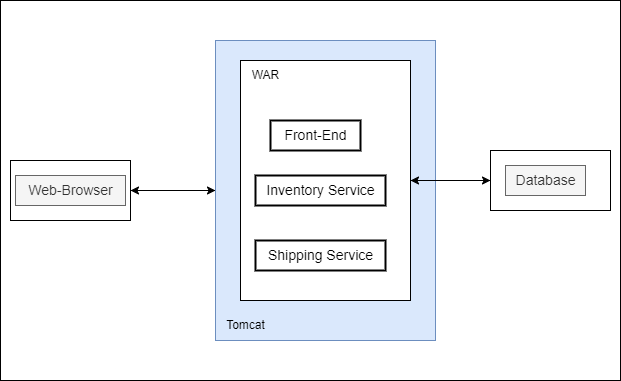When we talk about software architecture, the legacy way of creating software was monolithic architecture. So let’s try to understand what basically a monolithic architecture is and why software developers were using that for the long term.
Monolith means “a single block or piece”, basically this term is used in reference to rocks or architecture. Similarly, a monolithic software architecture is a single application having multiple roles and responsibilities. This can be understood with the example shown below:
In this example, we have a traditional web application that is used for e-commerce purposes.

So, as we can see in the above diagram the whole application is a single WAR file. This means all the components which are needed are present in a single package or single unified unit. This architecture basically suits small-scale projects or projects which are in their early stages. once the project becomes huge it becomes hard to make modifications to the project.
Advantages Of Monolithic Architecture :
There are lots of advantages of this architecture, that’s why it’s been used for a very long time in the software industry and is still being used in many organizations for their projects. Here we will try to understand what can be the advantages of this architecture and which type of projects can use this.
Advantages of Monolithic Architecture include:
- Ease of Deployment: Since it has only a single deployment file so it becomes easy to manage the deployment of the project.
- Development: As it has a single code base the application created using this architecture is easy to develop. So less management in terms of the tech stack is needed.
- Performance: As it has a single code base and repository there is less time taken to call the API as compared to microservice architecture.
- Simplified Testing: End-to-end testing becomes very easy as everything is a centralized unit, and testing operations can also be performed faster than distributed applications.
- Easy Debugging: It becomes easy to debug as the code is present in a single place
Disadvantages of Monolithic Architecture :
As monolithic architecture is a tightly bound unified architecture type it shows serious problems in many cases. In 2009 Netflix Faced an issue in scaling its application. Due to high demand, they started facing high traffic. To keep up with the demand Netflix moved its private data center to the public cloud and migrated from Monolithic Architecture to Microservices Architecture.
Disadvantages of Monolithic application includes :
- Slow Development Speed: The Complexity and the size of the application are directly proportional, So as the size of the application increases the complexity of developing the application also increases. Which results in a slower development process.
- Scalability: It’s nearly impossible to scale the individual component.
- Complex Modification: As there is a single deployment file that contains all the services and resources, it becomes challenging to do modifications to the application. Each time an improvement is needed the whole application needs to be redeployed.
- Reliability: If any module fails after the deployment of the application, it could result in the failure of the entire application.
- High Management Cost: As the application becomes more extensive, it becomes complex to handle, which eventually results in the project’s high cost. Also, if some error persists and the application goes down, it results in downtime and leads to business loss.
- The barrier to technology Adoption: Newer technology stack or framework are harder to adapt as it results in High costing and consumes a lot of time.
So, from above we can understand that monolithic architecture can be both beneficial and loss-making. It can be best utilized for small use cases and POCs so as to save cost and time. Whereas for the larger application where there is a frequent need for concurrent modification, scalability, and Different technology stacks we should avoid using this architecture.